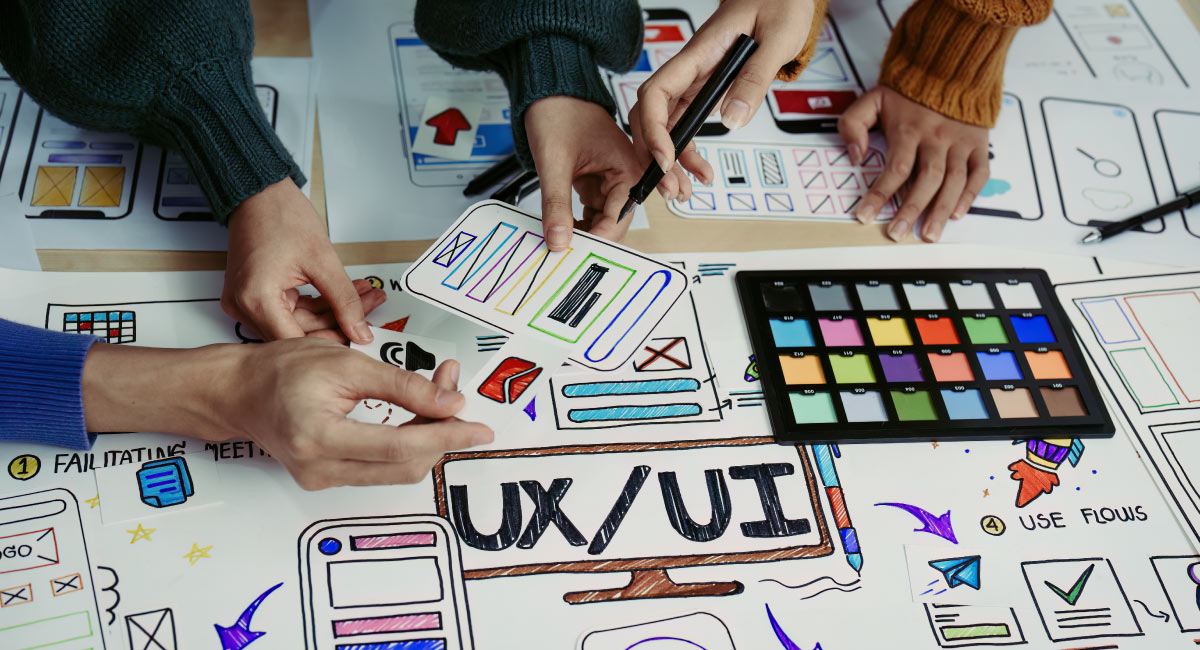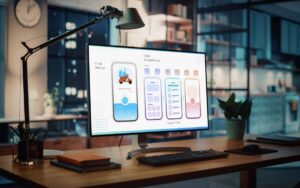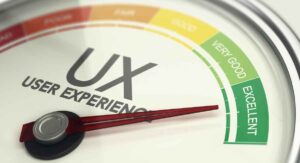To meet customer demands and market changes, businesses are under mounting pressure to take their digital presence to the next level. One of the most effective ways to achieve this is by designing digital products and experiences that engage users through stunning visuals and interactions. That’s where UI/UX design comes into the picture.
This guide will explore the key differences and similarities between UX and UI design processes. We will also discuss the elements of the UX/UI skillset and how enrolling in an industry-recognized UI/UX design bootcamp can help you acquire the essential skills.
What is UI Design?
UI design is the practice of creating the aesthetics and the interactive elements that make up the user interfaces. The UI designer uses market research and sentiment analysis information to design elements such as color schemes, typography, images, videos, animation, CTA buttons, and scroll bars. They also establish the locations of the elements to make the digital application user-friendly.
The website of the design and experience firm Curious and Company is a good example of an engaging UI design. The UI is designed to showcase the talents of the firm. The overall nature of UI gives the vibe of mystery and discovery. The color scheme comprises darker shades, and the cursor is the shape of a hand. The CTA buttons are in the form of a cloth ringer that is pulled when the user clicks it. The hidden images on the dark screen are revealed as the cursor moves. The process of designing and creating all these major and minor aspects forms UI design.
What is UX Design?
UX design involves researching the target users, collating the information, and conceiving a framework on which the actual application will be based. The designer uses data to create user personas and irons out the specific requirements for the users. They ensure that the application framework is designed to make the user’s journey through the application as smooth as possible. The motive of the UX design is to provide the UI design a base on which the multiple elements are based.
For example, the UX design of the website CoffeeGeek focuses on coffee lovers worldwide. The design considers the possible questions that the visitors may ask, such as the types of coffee, the best places to buy, the latest coffee machine, and recipes. The user personas for this website are baristas, tasters, coffee connoisseurs, café owners, coffee machine manufacturers, and coffee bean producers and sellers. There is a feature that caters to each of these personas. Further, the microcopy of the website is designed such that the titles are short but include at least one coffee-related term. The UX design ensures that the images are professional, aesthetically pleasing, and visually tempting.
Another good example is the official website of the French luxury fashion house Chanel. It uses a no-frills framework that showcases the key events and products. The UX design ensures the user can immediately locate the products they seek. On opening, the website takes the user directly to the page customized for the user’s location. A high-contrast accessibility feature is provided at the bottom of the page. The UX ensures the photos and videos used throughout the website are professional, magnified, and lucid. They also include videos to give the users a glimpse into the jewelry design process. The UX design of the Chanel website is to attract users visually and encourage them to click the ‘Order’ button.
The Relationship Between UX and UI Design
UX and UI complement each other and are mutually useful. While the UX provides a path for the UI to follow, the UI brings the ideas in the UX to life. UI further identifies areas that may seem necessary in the UX but are impractical. The UX design uses this data to finetune the user journey further and include new aspects per the user feedback.
Let’s say you are responsible for both UX and UI design. You cannot directly take up the task of UI and begin working on the application. You will have to conduct a literature review and user survey and create user personas for the UX design. Further, you will map out the user journey and determine the requirements of each step of the journey. The UX design will then require creating wireframes. You need some knowledge about color theory, typography, and coding to know what can and can’t be done in the UI design.
Only after prototype testing will you work on the website by choosing color palettes, fonts, images, videos, and animations. This is where you will begin UI designing. Here, you are not overly concerned about user personas but are more focused on getting the application into an actionable and attractive condition. If you realize some of the planned features are impractical, you return to UX design and modify it accordingly.
UX vs. UI Design: Key Differences
UX and UI may seem intertwined. However, there are subtle differences that work to make both design processes reach their maximum potential to offer an amazing user experience. Let us go through some of them:
| UX design | UI design |
| Answers the question ‘What to achieve?’ | Answers the question ‘What to make?’ |
| Deals with conceiving and planning the user journey through the product | Deals with establishing and executing the various elements of the user interface |
| A high-level perspective of the product | A detailed perspective of the product |
| Envisages the feel of the appearance and functionalities of the product | Envisages the user interface in the most captivating and user-friendly manner |
| Entails creating the wireframe and prototypes | Entails construction elements of the interface such as typography, CTA buttons, scroll bars, layout, videos, etc. |
| Includes performing user research and sentiment analysis to create user personas and determine key user requirements. | Includes conducting competitor research to assess the rank and performance of the application against the competitor applications. |
| Involves composing and finalizing the microcopy to be lucid, concise, and informative. | It involves determining the text color, font, calligraphy, and orientation to make the microcopy conspicuous. |
| Focus on the effectiveness of the product | Focus on the attractiveness of the product |
| Applicable physical as well as digital products | Applicable to only digital products |
| Uses empathy maps, site maps, task flows, and customer journey maps | Uses mood boards, branding, style tiles, and user testing. |
| Transitions to UI design | Transitions to final design |
What Do UX Designers Do?
UX designers are responsible for visualizing the product from a user perspective and drafting a workable plan. They are involved in assessing user requirements, developing strategy, creating and testing prototypes, and collaborating with the UI designers to render the final application.
As a UX designer, you will conduct user research and sentiment analysis to assess how the users want a particular product to feel, such as a smooth purchasing experience and clarity in the function of the tabs and buttons. They collaborate with multiple departments to determine the metrics that decide the application’s usability.
They then establish the major features of the product. Further, they design and create a wireframe to assemble all the data and visualize the application. They are also responsible for testing the prototypes and identifying areas needing improvements or modifications.
As a UX designer, you will also compose the microcopy to be inserted throughout the application interface. The microcopy must be clear and understandable in all the languages the application supports.
Finally, the UX designers also conduct user feedback and surveys to assess the problems with the application and work on updating and improving the application.
What Do UI Designers Do?
The UI designers create the final user interface. As a UI designer, you must dive into the creative side of your brain to bring about an amalgamation of aesthetics and functionality. They have to ensure that the brand style is maintained throughout the design.
They work on the UX wireframes and create the specifics. They brainstorm on the color scheme, typography, and responsive and interactive elements in the interface. They determine the most appealing photos, sounds, animations, and videos and place them at the appropriate locations on the interface. They then decide the shape, size, and location of tabs, CTA buttons, scroll bars, and cursors.
UX designers have to be on their toes to constantly update the application with the latest releases, products, blogs, and announcements. They are responsible for keeping the websites live and vibrant. The designers also need to keep assessing the ranking of the applications and websites. They must explore trends compatible with the application to improve the user experience.
Key Skills to Have for a UX/UI Design Career
Enterprises prefer UX/UI designers who are attentive to details, creative, great collaborators, exceptional problem solvers, and excellent communicators. Apart from these, UX designers are required to possess certain unique skills. Here’s a quick list of the key skills you should remember.
- Experienced in building high-level wireframes, flows, information architecture, and prototypes, including navigation menus, hierarchies, and labeling.
- Conversant with creating user personas and applying user testing methods and agile development processes
- Expert in data and feedback collection from users, engineers, product managers, designers, stakeholders, and sales and marketing teams
- Familiar with drafting design specifications and using designing enterprise software.
- Knowledgeable about tools such as Figma, Sketch, AdobeXD, InVision, Zeplin, and Illustrator.
- Acquainted with HTML and CSS
- Experienced in copywriting and microcopy
- Basic knowledge of visual design and responsive design
Meanwhile, aspiring UI designers must have a different skill set that includes the following:
- Knowledgeable about coding, HTML, CSS, JavaScipt, etc. Experience with front-end development is a plus.
- Expertise in one or more tools such as Figma, Invision, UXPin, Adobe Photoshop, Quartz, and Adobe Illustrator
- Conversant with design paradigms and aesthetics
- Familiar with color theory, typefaces, iconography, and visual scripting
- Experienced in graphics, mockups, and layouts
- Acquainted with creating and integrating interactivity, animations, forms, menus, and micro-interactions
A future-ready UX/UI design program will train you in both skill sets and lead you to a successful career in this field!
How to Become a UX/UI Designer
If you have found your calling as a UX/UI designer, there are some steps you should take to become one.
Step 1. Choose an appropriate undergraduate and postgraduate course. Most top recruiters in this field prefer individuals with a background in Computer Science, Graphic design, Interaction design, and industrial design. If you are a graduate from any other stream but wish to transition, you can explore postgraduate courses in the relevant branches.
Step 2. Cultivate the right technical and soft skills. Invest in courses to learn the essential tools and software. If you are from a diverse educational background, select a reputable course that will take you through the basic and advanced concepts. Identify your strengths and interests and work on adding to them.
Step 3. Build a portfolio of myriad projects. Make your online presence felt by creating profiles on websites such as WordPress, Behance, Dribble, UXfolio, Notion, Squarespace, and Wix. Work on showcasing your skills in as many case studies as possible. You can also present your coding skills by coding applications from scratch.
Step 4. Connect with peers on social media such as LinkedIn. They can provide feedback on your work and guide you.
Step 5. Continue self-learning by exploring current magazines, blogs, and YouTube videos for the current trends and new features. Keep learning new tools and technologies that can be used and integrated into the UX/UI design.
Get Started on Your Path to a Successful UI/UX Design Career
UX/UI design is a lucrative career in today’s digital age. UX/UI designers play a massive role in building memorable digital products and innovative experiences. If you’re passionate about visual design and have strong creative and technical skills, this could be your ideal career.
If you want to get started, a comprehensive UX/UI design course can help you. The program is structured to equip you with skills in design thinking, heuristic evaluation, empathy mapping, clickstream analysis, and persona mapping. Besides getting a solid grasp of core concepts, you get hands-on training in user testing, accessibility, wireframing, and using AI, AR, and VR in UX/UI design.
Get mentored by industry experts, boost your CV through capstone projects, and build a portfolio that helps you stand out — it’s all in here!






